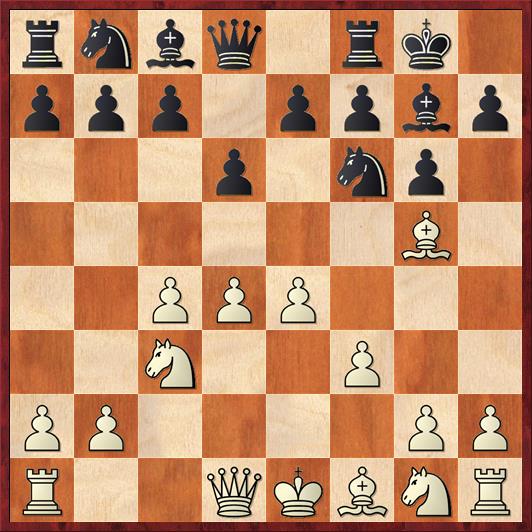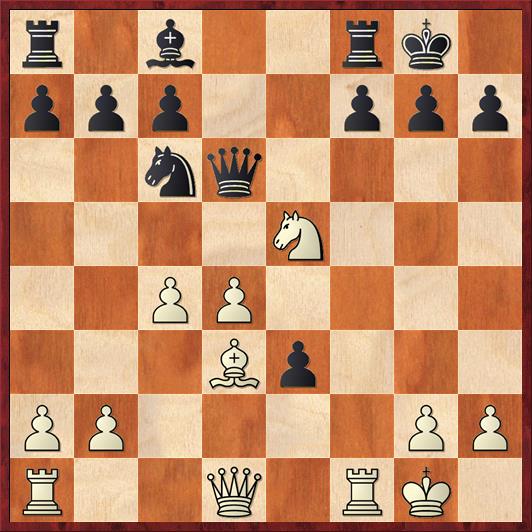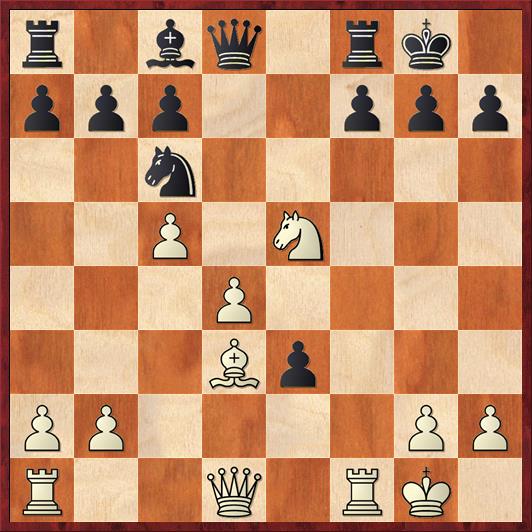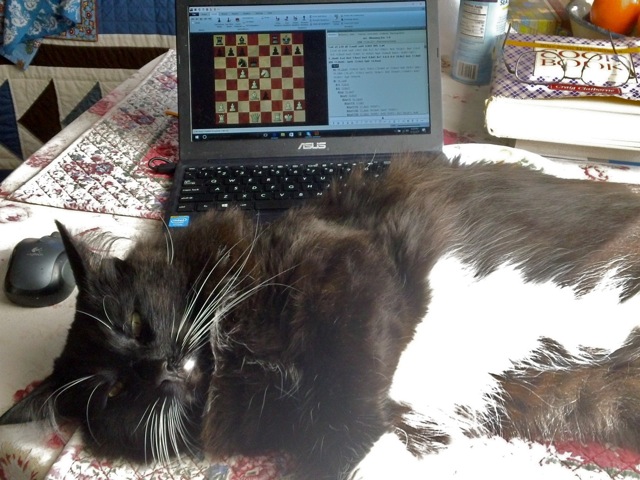Yesterday I met again with Gjon Feinstein and Mike Splane, this time with Eric Montany as our fourth. For the last two years he has been working on a book, and this was the first time he had gotten together with us since he finished.
Until this weekend, Eric had never revealed to us what the book was about, other than “a major but not main-line variation in a very popular opening.” Now, with the book all written and waiting to be published, he was able to reveal the topic: the Saemisch Variation of the King’s Indian Defense. The official date of publication is August 7, and you can pre-order the book at Amazon right here.
I can tell you a little bit more about the premise of the book. It’s a repertoire for White, and Eric advocates the line 1. d4 Nf6 2. c4 g6 3. Nc3 Bg7 4. e4 d6 5. f3 (the Saemisch Variation) O-O 6. Bg5. This is the “tabiyah” for the book.
 Position after 6. Bg5. Black to move.
Position after 6. Bg5. Black to move.
FEN: rnbq1rk1/ppp1ppbp/3p1np1/6B1/2PPP3/2N2P2/PP4PP/R2QKBNR b KQ – 0 6
The main line of the Saemisch is considered to be 6. Be3, but Eric argues that White’s bishop is better placed on g5 in many variations. In fact, there are some subvariations of the 6. Be3 line where White later moves the bishop to g5, so why not move it there in one step?
One reason, of course, is that Black can put the question to the bishop with 6. … h6. Now White replies 7. Be3, and we are back to the main line except that Black has his pawn on h6 instead of h7. Eric argues that Black will either be forced to sacrifice the h6 pawn or else waste a tempo to protect it with … Kh7. This, he says, makes White’s position significantly better than in the regular main variation with the pawn on h7.
Of course I am not qualified to evaluate Eric’s argument. He has 350 pages of detailed analysis! The book is a true labor of love, and I respect that.
Speaking of labors of love, we played a few games of speed chess and I got to have my (weekly?) King’s Gambit adventure. Eric played the same variation against me that Mike Arne did last week: 1. e4 e5 2. f4 d5 3. ed ef, the Modern Variation. Both of us made a lot of mistakes, so I don’t think that there is any value in going over the opening, but we got to this very interesting position:
 Position after 13. … Qd6. White to move.
Position after 13. … Qd6. White to move.
FEN: r1b2rk1/ppp2ppp/2nq4/4N3/2PP4/3Bp3/PP4PP/R2Q1RK1 w – – 0 14
Both Mike and Gjon, who were watching, told me after the game, “You missed something here.” The move I played was 14. Nxc6? Eric responded 14. … Qxc6?, which according to Rybka is incorrect. The funny thing was that Eric suspected as much. He said, “The kids today would probably play 14. … dc without batting an eye,” but he just couldn’t bring himself to ruin his pawn structure.
As it turns out, Rybka thinks that Black would have had about a 0.4-pawn advantage after 14. … bc 15. c5 Qd8. The reason that 14. … bc is better than 14. … Qxc6 is that Black maintains pressure on White’s weakness, the pawn on d4. Even though the pawn is safe for now, the need to babysit it complicates my efforts to win back the pawn on e3. After 14. … Qxc6, Rybka says I should play 15. Qf3, which wins back the e3 pawn easily. The trouble is that it also leads to a very dull sort of equality. Instead I played the unsound 15. Rf4? but nevertheless won after a few more mistakes.
Now let’s go back to the diagram. What should I have played instead of trading knights? The answer, you have probably figured out, is 14. c5! The point that I missed is that 14. … Qxd4? runs into 15. Nxc6! If 15. … e2+ 16. Nxd4 edQ 17. Raxd1 wins a piece for White. Also, 14. … Qxc5 15. Rc1 Qb6 16. Bxh7+! wins.
Why did I miss this? In the midst of a 5-minute game, I was just too intimidated by Black’s discovered check … e2+ and I did not put forth the effort to analyze it carefully. Discovered checks always look terrifying in speed chess. Given time to analyze them calmly, they often prove to be less terrifying than we think. In this case, I didn’t even have to analyze that deeply — only three moves.
Now for a quiz: What if Black, instead of falling for the trap with 14. … Qxd4? just tries to get to the same position that we said was good for him before? Suppose he plays 14. c5! Qd8! What now?
 Position after 14. … Qd8 (analysis). White to move.
Position after 14. … Qd8 (analysis). White to move.
FEN: r1bq1rk1/ppp2ppp/2n5/2P1N3/3P4/3Bp3/PP4PP/R2Q1RK1 w – – 0 15
If I play 15. Nxc6 bc, we just transpose into a line that Rybka already said was good for Black. Also, 15. Bc4 Nxe5 looks too slow. So there must be something better for White.
I’ll leave this for you to figure out, because there are lots of cool lines to calculate. They go a lot more than three moves deep. The position is a King’s Gambiteer’s dream, with sacrifices on f7 and h7 begging to be played. But only one of them is right. Which one?
 Max is working hard on the quiz. No fair peeking at the computer screen for the answer!
Max is working hard on the quiz. No fair peeking at the computer screen for the answer!


